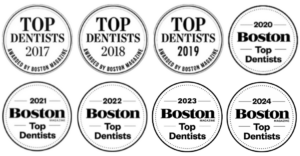What Should I Do If My Invisalign Aligner Doesn’t Fit?
Advancing to a new set of Invisalign aligners is an exciting time. It means that you’re making real, tangible progress towards your beautiful new smile. But what happens when your aligners don’t fit on your arches? After all, if you can’t get them onto your teeth, how can they move them? If you’re having trouble getting your trays on, here are a few tips and tricks you can try to keep your new smile right on schedule.
Chewies
You may have already heard of Invisalign Chewies. These handy little reusable devices can be used for many things, including helping to put your aligners on. To use them, simply bite down on your Chewie starting at the back of your arch, and then slowly slide the Chewie forward, biting down until the aligner is completely in place.
Put it in Reverse
If using a Chewie still doesn’t help get your trays on, it’s possible that you need to go back to your previous pair, but make sure you have your dentist’s approval before you do this. While it shouldn’t set your treatment timeline back too far if this happens occasionally, if you notice that you are struggling regularly to get your aligners on and having to backtrack frequently, make sure you’re wearing them for at least 22 hours a day. If you aren’t meeting the minimum requirements for time, your teeth won’t move on schedule and your trays won’t fit when they’re supposed to.
Bite Exercises
Bite exercises are movements you can make with your jaw that help encourage your teeth to move, especially your front teeth. Even if they seem silly or you don’t think they’ll do anything, they truly can help keep your treatment on track and ensure that your smile is moving on schedule!
Other Reasons Your Aligners May Not Fit Properly
If your aligners are damaged, it could be difficult to get a proper fit. To prevent them from changing shape, make sure you never wear them while you’re eating or drinking anything other than cold or room-temperature water. Hot foods and beverages can cause them to melt or warp, which will make it harder for them to fit correctly.
Remember, Invisalign is a faster, easier way to align your smile, but if you don’t wear your trays, your teeth won’t move into their proper alignment. If you’re struggling to get your aligners on, try these tips, or contact your dentist for more help.
About Our Practice
At Lexington Smile Studio, our trio of talented dentists are ready to give you your best smile ever. We are proud to offer a variety of dental treatments ranging from preventive care to cosmetic improvements and everything in between. If you’re ready to get straighter, more evenly- spaced teeth easier and faster than with traditional orthodontics, Invisalign aligners could be the answer. To learn more about this treatment and to see if it can benefit you, please schedule a consultation with us today by visiting our website or calling us directly at 781-773-2076.



